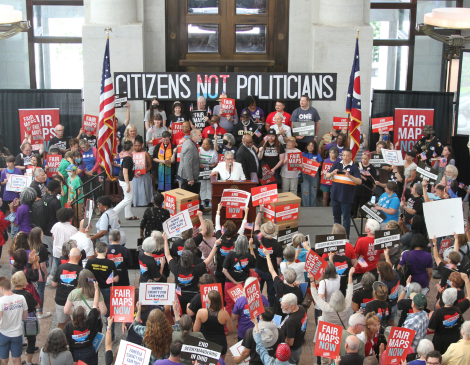Issue 1 on November’s statewide ballot asks each Ohio voters a clear-cut question: Shouldn’t you run this state, rather than let a clique of partisan hacks call the Statehouse’s shots?
That’s the issue: Stopping the rigging of Ohio General Assembly districts by GOP insiders, some of them on politics’ kook-wacko fringe, who’ve drawn legislative districts to favor Republican candidates. Seems the party of robust, magic-of-the-market competition doesn’t really like it.
District-rigging or “gerrymandering” distorts Ohio House of Representatives and state Senate districts so they are much more likely than not to send Republicans to the General Assembly.
That, in turn, means the GOP’s springtime primary elections, not November’s general elections, can be where Ohio’s legislators are actually picked.
And Republican primary contests often hinge on who is furthest to the right. So, while Ohioans’ personal incomes may lag, and legislators nickel-and-dime public schools, still — to give credit where it’s due — our peerless legislature takes a back seat to nobody when it comes to denouncing transgender people.
Data proves need for Ohio Issue 1
The Brennan Center’s Gina Feliz and Yurij Rudensky reported some troubling information earlier this year.
“More than 9 million Ohioans (about 77% percent of the state’s population) live in districts where elections for state representatives are not in serious dispute,” they said. “That is, these districts are either uncontested, or they give one party a disproportionate advantage in the general election so that the district is uncompetitive, even if it’s formally contested.”
What’s more, of the 99 Ohio House districts, 15 are uncontested, so the challenge-free 15 who were nominated at March 19’s primary election might as well pick out their Riffe Center offices now. (About 1.5 million Ohioans live in those uncontested state House districts, Feliz and Rudensky found.)
Their data-rich research highlights this arresting fact: Minus the 15 uncontested Ohio House districts, that leaves 84, “but because 62 … have been drawn as safely Republican or Democratic seats … their outcome in the general election is not in serious dispute … [That is] … about 9.1 million Ohioans – 77% of the total population – live in districts that will be uncontested or uncompetitive this November.”
That’s completely outrageous. Functionally, the General Assembly is about as representative as China’s National People’s Congress — not the kind of government that Ohioans want or deserve.
A real solution to end gerrymandering
The statewide “Citizens Not Politicians” campaign, which led the successful drive to place Issue 1 on November’s ballot, says the measure – if voters approve it – would create a 15-member Ohio Citizens Redistricting Commission, composed of Democrats, Republicans and Independents. They’d be required to draw fair districts. And Issue 1 would forbid former politicians, party officials and Statehouse lobbyists to be members of the commission.
A telling feature of the “Citizens Not Politicians” pro-Issue 1 campaign: Among its strongest supporters is the retired chief justice of Ohio’s Supreme Court, Maureen O’Connor, a Republican. (O’Connor served earlier as Ohio’s lieutenant governor and as Summit County’s prosecuting attorney).
As chief justice, O’Connor was part of a cross-party group of justices who repeatedly fought Statehouse insiders who aimed to rig General Assembly districts to favor the GOP, she says in a recent Yes-on-Issue 1 broadcast ad:
“Seven times, career politicians have so blatantly gerrymandered our voting district maps that the Ohio Supreme Court ruled the maps unconstitutional,” O’Connor said. “I know, because I was chief justice on that court.”
(Since her retirement, the court has regressed into the partisan GOP backwater it long has been but for roughly a decade spanning the 1970s and ‘80s, when Democrats won a court majority.)
Gerrymandering Statehouse politicians are lying about Issue 1, O’Connor says, “so let me set the record straight. Issue 1 bans politicians from drawing voting maps. It will restore power to where it belongs – with citizens, not politicians.”
That echoes what Ohio’s Bill of Rights says: “All political power is inherent in the people.” Ohioans should exercise that power by voting “yes” on Issue 1, reclaiming for themselves the fair General Assembly districts that Statehouse partisans have denied them.
Read the original piece here.

